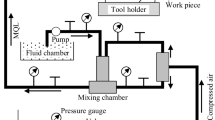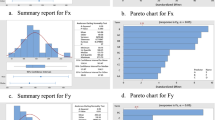Abstract
In micromachining, the uncut chip thickness is less than the cutting tool edge radius, which results in a large negative effective rake angle. Depending on the material properties, this large negative rake angle promotes built-up edge (BUE) formation. A stable BUE acts like a cutting edge and affects the mechanics of the process. The size of the BUE increases with increasing uncut chip thickness and cutting speed. It also creates a positive rake angle, but it decreases the clearance angle of the tool. A method of including BUE formation in finite element simulations is to use sticking friction conditions at the tip of the tool. However, this approach is shown to be insufficient to simulate BUE formation in microscale machining. Therefore, the cutting edge is modified with the experimental BUE size in the finite element simulations based on experimental measurements. The influence of friction models between BUE and the work material has been investigated, and the study identifies friction coefficients that yield good agreements with experimental results. The finite element model is shown to be capable of simulating process forces and chip shapes for uncut chip thickness values larger than minimum uncut chip thickness.
Similar content being viewed by others
References
Nano and micromachining, J. Paulo Davim (Editor), Mark J. Jackson (Editor) ISBN: 978–1–84821-103-2, December 2008, Wiley-ISTE
Câmara MA, Campos Rubio JC, Abrão AM, Davim JP (2012) State of the art on micromilling of materials, a review. Journal of Materials Science & Technology 28(8):673–685
Cardoso P, Davim JP (2012) A brief review on micromachining of materials. RevAdv Mater Sci 30:98–102
Lucca DA, Seo YW (1993) Effect of tool edge geometry on energy dissipation in ultraprecision machining. Ann CIRP 42(1):83–86
Lamikiz A, López de Lacalle LN, Sanchez JA, Bravo U (2005) Calculation of the specific cutting coefficients and geometrical aspects in sculptured surface machining. Mach Sci Technol 9(3):411–436. doi:10.1080/15321790500226614
Uriarte L, Azcárate S, Herrero A, Lopez de Lacalle LN, Lamikiz A (2008) Mechanistic modelling of the micro end milling operation. Proc Inst Mech Eng B J Eng Manuf 222:23–33
Zhang X, Ehmann KF, Yu T, Wang W (2016) Cutting forces in micro-end-milling processes. Int J Mach Tools Manuf 107:21–40
Srinivasa YV, Shunmugam MS (2013) Mechanistic model for prediction of cutting forces in micro end-milling and experimental comparison. International Journal of Machine Tools Manufacture 67:18–27
Malekian M, Park SS, Jun MBG (2009) Modeling of dynamic micro-milling cutting forces. International Journal of Machine Tools Manufacture 49:586–598
Gonzalo O, Jauregi H, Uriarte LG, López de Lacalle LN (2009) Prediction of specific force coefficients from a FEM cutting model. Int J Adv Manuf Technol 43:348. doi:10.1007/s00170-008-1717-9
Afazov SM, Ratchev SM, Segal J (2010) Modelling and simulation of micro-milling cutting forces. J Mater Process Technol 210:2154–2162
Jin X, Altintas Y (2012) Prediction of micro-milling forces with finite element method. J Mater Process Technol 212:542–552
Lazoglu I, Mamedov A (2016) Deformation of thin parts in micromilling. CIRP Ann Manuf Technol 65:117–120
Hartung PD, Kramer BM (1982) Tool wear in titanium machining. Annals of CIRP 32:75–80
Kümmel J, Gibmeier J, Müller E, Schneider R, Schulze V, Wanner A (2014) Detailed analysis of microstructure of intentionally formed built-up edges for improving wear behaviour in dry metal cutting process of steel. Wear 311:21–30
Kümmel J, Braun D, Gibmeier J, Schneider J, Greiner C, Schulze V, Wanner A (2015) Study on micro texturing of uncoated cemented carbide cutting tools for wear improvement and built-up edge stabilisation. J Mater Process Technol 215:62–70
Oliaei SNB, Karpat Y (2016) Investigating the influence of built-up edge on forces and surface roughness in micro scale orthogonal machining of titanium alloyTi6Al4V. J Mater Process Technol 235:28–40
Gomez-Parra A, Alvarez-Alcon M, Salguero J, Batista M, Marcos M (2013) Analysis of the evolution of the built-up edge and built-up layer formation mechanisms in the dry turning of aeronautical aluminium alloys. Wear 302:1209–1218
Desaigues JE, Lescalier C, Bomont-Arzur A, Dudzinski D, Bomont O (2016) Experimental study of built-up layer formation during machining of high strength free-cutting steel. J Mater Process Technol 236:204–215
Waldorf DJ, DeVor RE, Kapoor SG (1999) An evaluation of ploughing models for orthogonal machining. J Manuf Sci Eng 121:550–558
Fang N, Dewhurst P (2005) Slip-line modeling of built-up edge formation in machining. Int J Mech Sci 47:1079–1098
Karpat Y (2009) Investigation of the effect of cutting tool edge radius on material separation due to ductile fracture in machining. Int J Mech Sci 51(7):541–546
Kim J, Marinov VR, Kim D (1997) Built up edge analysis of orthogonal cutting by the visco plastic finite element method. J Mater Process Technol 71:367–372
Childs THC (2013) Ductile shear failure damage modelling and predicting built-up edge in steel machining. J Mater Process Technol 213:1954–1969
Atlati S, Haddag B, Nouari M, Moufki A (2015) Effect of the local friction and contact nature on the built-up edge formation process in machining ductile metals. Tribol Int 90:217–227
Özel T (2006) The influence of friction models on finite element simulations of machining. Int J Mach Tools Manuf 46(5):518–530
Arrazola PJ, Ugarte D, Domínguez X (2012) A new approach for the friction identification during machining through the use of finite element modeling. Int J Mach Tools Manuf 48(2):173–183
Arrazola PJ, Özel T, Umbrello D, Davies M, Jawahir IS (2013) Recent advances in modelling of metal machining processes. CIRP Ann Manuf Technol 62:695–718
Thepsonthi T, Özel T (2013) Experimental and finite element simulation based investigations on micro-milling Ti-6Al-4V titanium alloy: effects of cBN coating on tool wear. J Mater Process Technol 213:532–542
Thepsonthi T, Özel T (2015) 3-D finite element process simulation of micro-end milling Ti-6Al-4V titanium alloy: experimental validations on chip flow and tool wear. J Mater Process Technol 221:128–145
Calamaz M, Coupard D, Girot F (2008) A new material model for 2D numerical simulation of serrated chip formation when machining titanium alloy Ti–6Al–4V. Int J Mach Tools Manuf 48:275–288
Sima M, Özel T (2010) Modified material constitutive models for serrated chip formation simulations and experimental validation in machining of titanium alloy Ti–6Al–4V. Int J Mach Tools Manuf 50:943–960
Liu R, Melkote S, Pucha R, Morehouse J, Man X, Marusich T (2013) An enhanced constitutive material model for machining of Ti–6Al–4V alloy. J Mater Process Technol 213:2238–2246
Zhang XP, Shivpuri R, Srivastava AK (2014) Role of phase transformation in chip segmentation during high speed machining of dual phase titanium alloys. J Mater Process Technol 214:3048–3066
Karpat Y (2011) Temperature dependent flow softening of titanium alloy Ti6Al4V: an investigation using finite element simulation of machining. J Mater Process Technol 211:737–749
Budinski KG (1991) Tribological properties of titanium alloys. Wear 151:203–217
Zhang L, Tanaka H (1997) Towards a deeper understanding of wear and friction on the atomic scale: a molecular dynamics analysis. Wear 211:44–53
Venkatachalam S, Liang SY (2007) Effects of ploughing forces and friction coefficient in microscale machining. J Manuf Sci Eng 129:274–280
Author information
Authors and Affiliations
Corresponding author
Rights and permissions
About this article
Cite this article
Oliaei, S.N.B., Karpat, Y. Investigating the influence of friction conditions on finite element simulation of microscale machining with the presence of built-up edge. Int J Adv Manuf Technol 90, 819–829 (2017). https://doi.org/10.1007/s00170-016-9456-9
Received:
Accepted:
Published:
Issue Date:
DOI: https://doi.org/10.1007/s00170-016-9456-9




